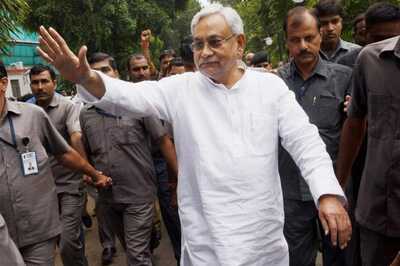
views
On the eve of India’s Independence Day, some 40 policemen at the remote outpost of Songudda, deep inside the jungles on the Madhya Pradesh Chattisgarh border, barely slept a wink.
It was not the customary vigil against Left radical violence in this Naxal dominated area that kept them awake. It was phone calls from their families celebrating the erection of a BSNL cellphone tower in the police station the previous day.
“Hum log raat bhar gharwalon se baat kar rahe the (we were talking to our families all night),” says Brijesh Mishra, who is part of the Hawk force and who would otherwise have to travel 40 km to Ukwa to find a cellphone signal.
Till now, BSNL had been unable to build a cellphone tower as there was no road to reach the place. That telephone tower and the road that made it possible is just one of the many small victories that Gulshan Bamra, 36, an IAS officer in charge of the district from 2006 to August 2009, managed against Naxalism in the district.
Songudda is one of several outposts in the densely forested Balaghat, Madhya Pradesh’s most backward district. Located at the state’s tri-junction with Chattisgarh and Maharashtra, it is also one of the 223 districts most affected by Naxals — Maoist insurgents. About 30 per cent or 400 villages of the district were considered unapproachable by the administration until just three years ago.
Every year, scores of unemployed boys and destitute girls joined Naxal cadres, more out of poverty and desperation than a clear idea of the armed revolution that Maoist ideologues exhort them to. Government officials considered a posting to this corner of the state a punishment.
When Gulshan Bamra was transferred to Balaghat as collector in 2006, he too was reluctant. He waited for a month hoping the government would change its mind. That did not happen, and eventually Bamra, a BSF havildar’s son from Jammu, arrived in Balaghat, armed with his middle class values and a worrying awareness of the district’s reputation.
“The first thing that comes to mind about Balaghat is Naxalism, forests and bamboo, in that order,” remembers Bamra, who moved back to Bhopal as director of women and child welfare a few weeks ago after a three-year stint in the border district.
But in those three years, what he has managed to achieve is nothing short of spectacular. Road connectivity in the district shot up from 520 km to 2,228 km.
About 28,000 hectares of new land came under irrigation. Tendu leaf (used in rolling beedies) collection and bamboo-cutting re-started. Revenues from forest produce nearly doubled from Rs 28 crore in 2006-07 to Rs 55 crore in 2008-09. Simultaneously, migration dropped sharply from 4,217 in 2005-06 to 2,840 last year as locals found work near their homes.
And the number of Naxalite attacks fell from 21 in 2005 to seven in 2008 and
none in 2009.
How did Bamra manage all this considering that the entire might of the state machinery has failed elsewhere in stemming Naxal violence and winning back the people?
He found the answer buried, ironically, in the very thing that the Naxals fight for — power to the people.
Ears to the Ground
When he took charge of the district with a population of about 1.5 million, Bamra used unofficial channels to understand why Naxalism was so deep-rooted and what the people needed. He was taken aback by what he learnt.
A television reporter, who had contacts among Naxals and had filmed one of their training sessions, told him: “To some extent, the Naxals are right.”
It was easy for the Maoists to recruit from the impoverished villages. People barely had work except during the kharif season from July to October.
During the rest of the year, they migrated to cities in search of jobs or joined the guerrillas who at least found means to get food. Large numbers of the recruits were girls who found that joining the Naxal dalams (groups) offered them security and sustenance.
PAGE_BREAK
To break the Naxal hold, Bamra decided to go to the people. The Maoists regularly helped villagers with first aid and medicines. So his administration began by organising medical camps at weekly haats (markets) where people from several nearby villages gathered.
It wasn’t easy, though. “When we did the first camp, we were very scared,” Bamra says. That was in a village called Sitapala where Naxalites had a lot of influence.
Some officials tried to dissuade him; his seniors advised him to go unannounced in a private vehicle. But how would the villagers then know that such a camp was being held and attended by district officials? That is when the superintendent of police came to the rescue. They went with full force. And it was a huge success.
“We were taking cues from the Naxal approach and doing it officially,” says Bamra.
He took teams of doctors such as skin specialists, orthopedics and gynecologists because the ailments they treated had a high incidence in these areas.
The police pitched in too with its own stock of emergency medicines. “Though it was meant for policemen, we started giving emergency treatment to villagers,” says Harinarayanachari Mishra, superintendent of police of Balaghat. “Nowadays, we stock medicines mostly for the people.”
The weekly haat offered another opportunity — to understand what the people really needed. Since people from several villages gathered, it became easy to organise meetings with village-level people’s representatives. About 115 such meetings were held across the district. And the problems that came to the fore were unemployment, abysmal road connectivity and small agricultural holdings with no irrigation.
Dispersed habitations, however, ensured that the district held very little ballot value, depriving it of political attention that would have brought funds for development. The newly launched National Rural Employment Guarantee Scheme (NREGS) solved that problem with plenty of funds becoming available for development, provided the administration was on its toes.
“The NREGP was tailor-made to solve such problems,” says Bamra. However, a well-funded programme such as NREGP can backfire in places like Balaghat.
With the huge funds and works in their hands, line departments were prone to arm twisting by vested interests and Naxalites. But the administration found the checks and balances in the 693 gram panchayats, 500 forest committees and 11,515 self-help groups.
Bamra gave priority to them as implementing agencies at the grassroots level. The strength of the line departments was harnessed for larger projects that required high technical expertise.
“I have seen that wherever the political system is functional, things work better,” says Bamra.
PAGE_BREAK
So, he made it his priority to bring about a proactive administration that focused on people-centric governance, integrated implementation of government-sponsored welfare programmes such as the rural job guarantee scheme, and sensitive policing to bring an alienated population back on the administration’s side.
All that required various departments to work in unison.
“A collector is merely a co-ordinator. He cannot force other departments to do something. His job is to get them to work together,” says Navneet Kothari, the present collector of Balaghat.
Bamra seconds that: “A collector is like a CEO of the district.” He found the way to achieving teamwork and effective governance lying buried in the panchayati raj enactments.
Except for revenue and police departments, the other 15 government departments are answerable to panchayats. Bamra set about making people aware of their powers and responsibilities.
Working with the People
While NREGP was implemented across the country, Balaghat also gave it an innovative turn. Instead of using the job guarantee funds in isolation, he integrated the use of development money under central schemes such as rural road building, the state government’s watershed programme and yearly plan funds around projects taken up under NREGP.
Since the programmes were devised according to local demand and monitored from panchayat level onwards, work was fast and effective.
One of the most important works undertaken jointly under the NREGP, public works department and Prime Minister’s Gram Sadak Yojana is the 90-km-long road connecting Ukwa near the district headquarters and Lanji on the eastern border with Chattisgarh’s Dantewada, considered a “liberated” district by Naxals.
Road-building is not an easy task in Balaghat, both because of the terrain and the Naxal threat. Bamra remembers a road contractor he once met. “He told me that he deserved a gallantry medal because he built a road from Lanji to Sali Tekri and took a bullet in the shoulder for that.” Similarly, a tender was floated to build a bridge a dozen times. “No one bid.”
So the construction work itself was divided. Building of long through roads such as the one connecting Ukwa and Lanji was given to the public works department and rural engineering services, while construction of links and approach roads was given to the local panchayats under the supervision and technical guidance of rural engineering services.
The Ukwa-Lanji route passes through tribal hamlets and police outposts along a high ridge that cuts across the heart of the forest in the district. Several unpaved roads now fork off this arterial creating a network that provides easy accessibility to both people and police.
That also solved BSNL’s problem of access to Songudda, which is one of the highest points on the ridge.
A dozen people in Songudda have already bought mobile phones. Manish Tripathi, a dare-devil police officer in charge of the station at Kirnapur on the edge of the forest, says it would help strengthen the informant network. “But then, the Naxals will also have mobile phones,” he says with a wry smile.
While the development works progressed, the police was consciously changing its approach too. Says district police chief Mishra, “We now focus on community policing. Instead of seeming authoritative and imposing, the police became friendly and helpful.
A lot of emphasis was laid on PPM [people’s perception management].”
The unstinted support from the police helped in the fast implementation of the development works.
The police began to help organise games and medical camps locally. Some articulate constables were regularly sent to schools to teach. It also began treating low-level Naxal cadres with more sympathy and understanding.
The strategy helped improve its informer network and many villagers who were earlier Naxalite sympathisers began to help the police. Mishra says that several times villagers have alerted them to ambushes, saving lives of cops who are routinely targeted by Naxals.
“Development work has been several times more effective in tackling Naxalism than our policing,” says inspector Tripathi, who looks more like a prize-fighter with a Kalashnikov.
The work did not go unnoticed by Naxalites, who wanted to stop it.
Says Songudda sarpanch, Tatu Seth, “The forest people [Naxalites] came to me and said the work [on the road] should be stopped. I asked them why should we block it when it will be good for us.”
Tatu Seth, who also runs the only shop in the village of about 800 people, says Naxalites are rarely seen these days and they have not been able to get any new recruits from the village.
“Now they claim that the development happened because of their presence. Otherwise, the administration would have ignored us as usual, they tell us.”
The peacekeeper
A civil servant in a Naxal-dominated district in Madhya Pradesh shows how to stem the violence and win back the people
PAGE_BREAK
Dousing the Inferno
There could be some truth in that argument. Balaghat gets large amount of funds and security precisely for its Naxalite affected status. Part of the Ukwa-Lanji road’s financing was taken care of by security related expenditure or SRE funds given to areas that have security concerns.
Balaghat’s, however, is a unique experience in an otherwise smouldering
arc of violence.
The influence of Naxalites has been on the rise in a geographically contiguous sickle-shaped swathe across the country extending from Jharkhand to the northern tip of Kerala, called the Red Corridor. International broking firm CLSA estimated in 2006 that Naxalite influence held to ransom over $80 billion in investments, much of that in the mineral-rich state of Jharkhand.
The central government now considers it the biggest internal security threat to the country.
A recent CPI (Maoist) Politburo document published in the Indian Express newspaper suggests that the guerrillas are extremely wary of losing people’s sympathy.
Terming an incident in Rajnandgaon in Chattisgarh where five polling officials and two policemen were killed in a Naxal attack as unfortunate, the Politburo note said that such mistakes should be thoroughly reviewed and disciplinary
action initiated.
Sitting in his office in Bhopal, Bamra says that the holistic approach to development was unique to Balaghat. “But what worked in Balaghat may not
work elsewhere.”
Behind him, a printout is stuck on the wall. It reads: Effectiveness (result-oriented approach) with sensitivity (respect for individual, thoughtful, responsive, responsible) and integrity (delivering on commitments, means should justify ends and fairness).
It is the department’s mission statement; a basic principle that has never failed to work anywhere.




















Comments
0 comment